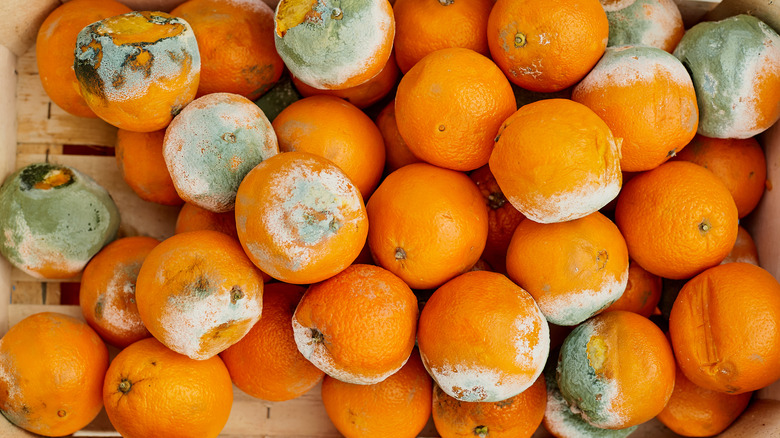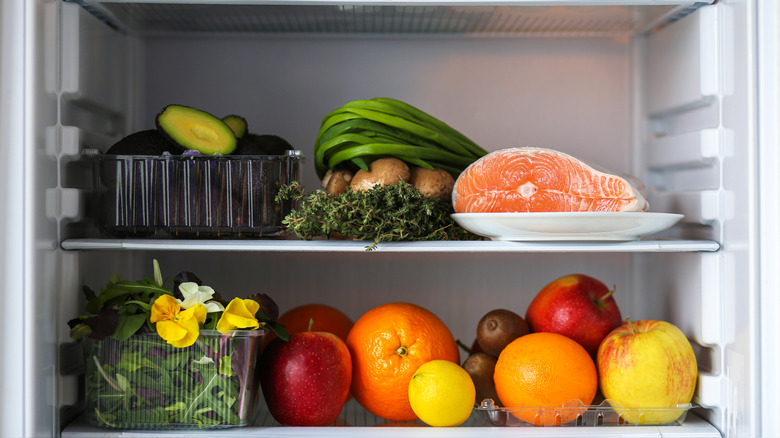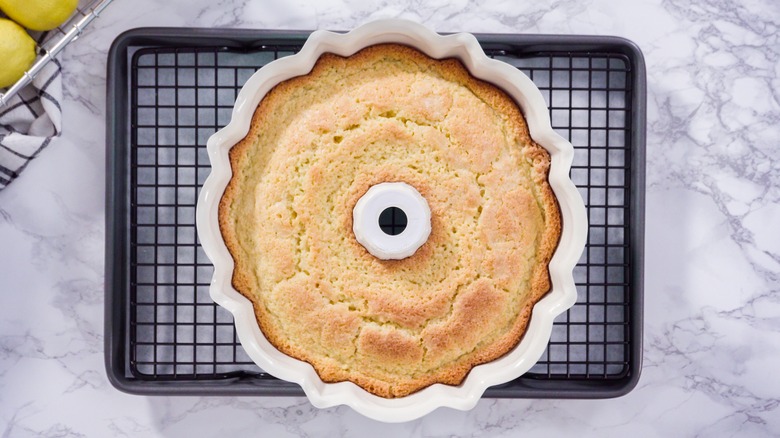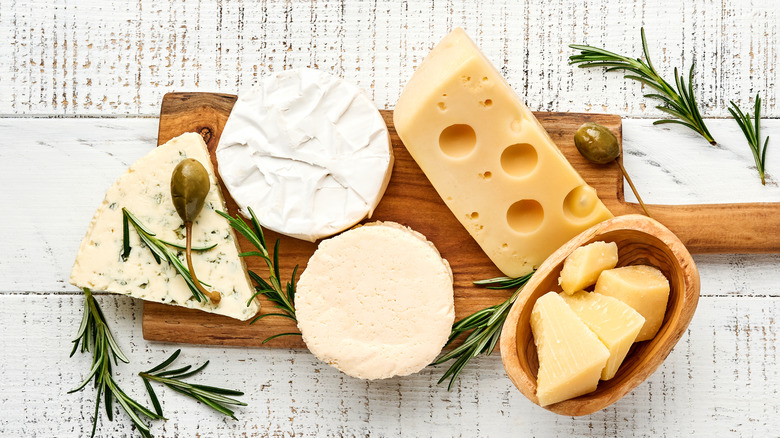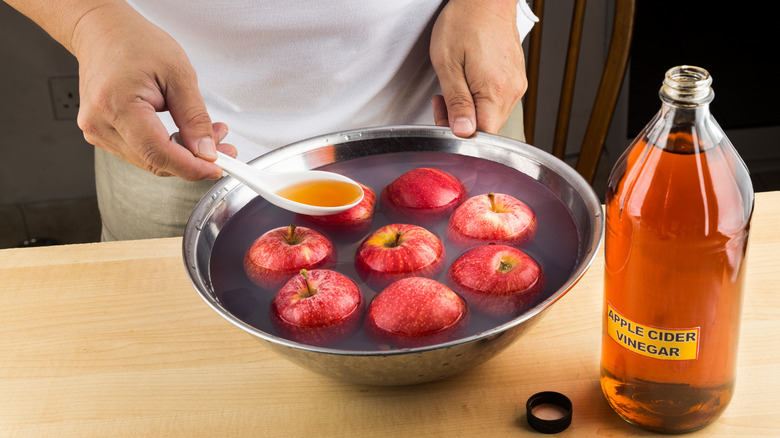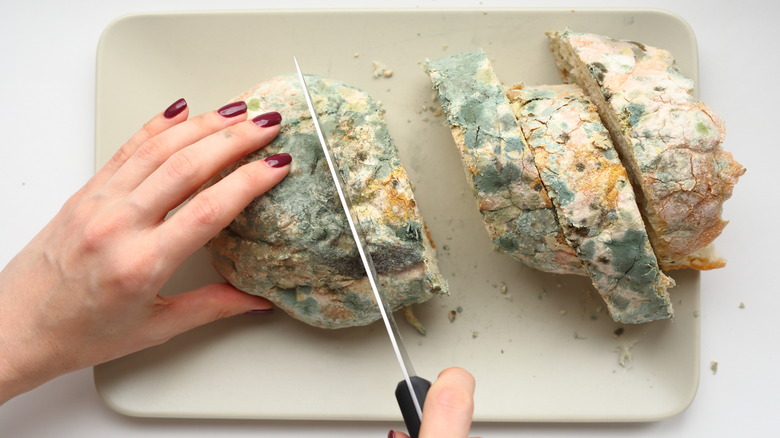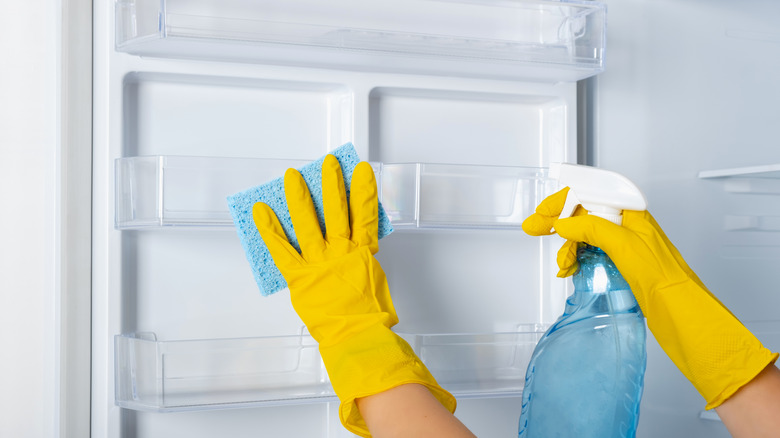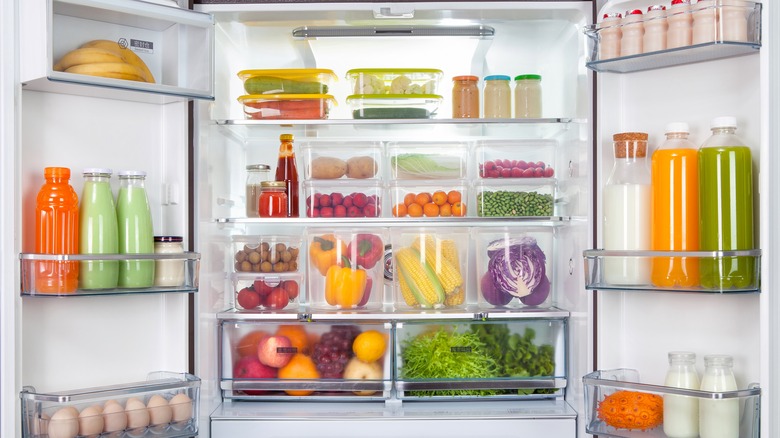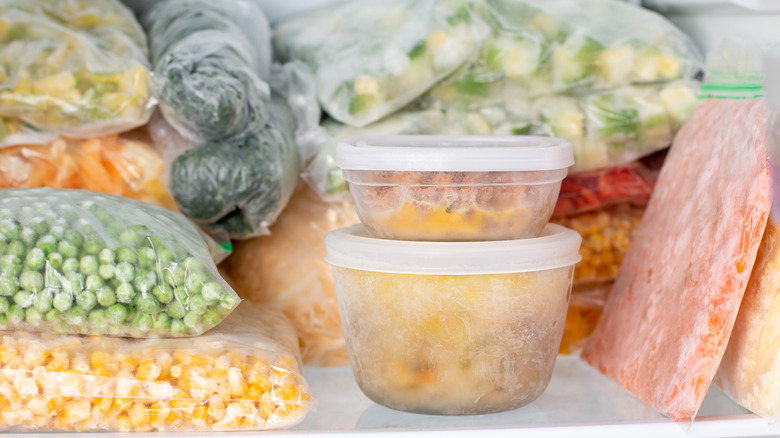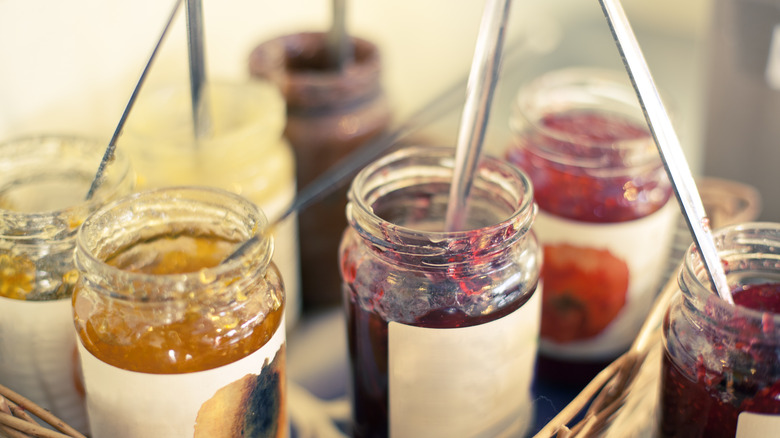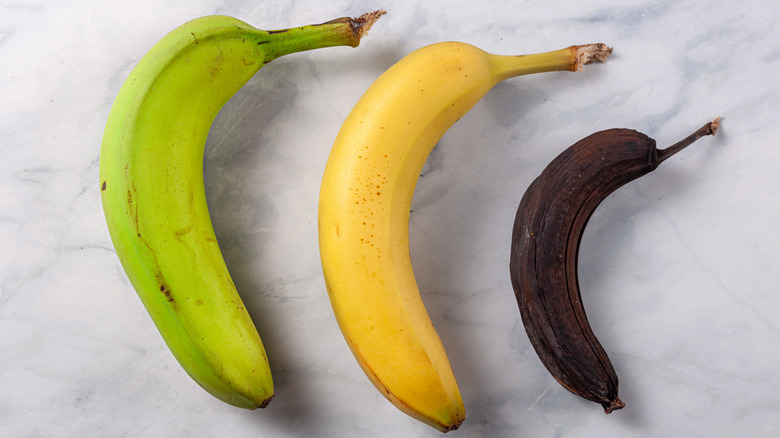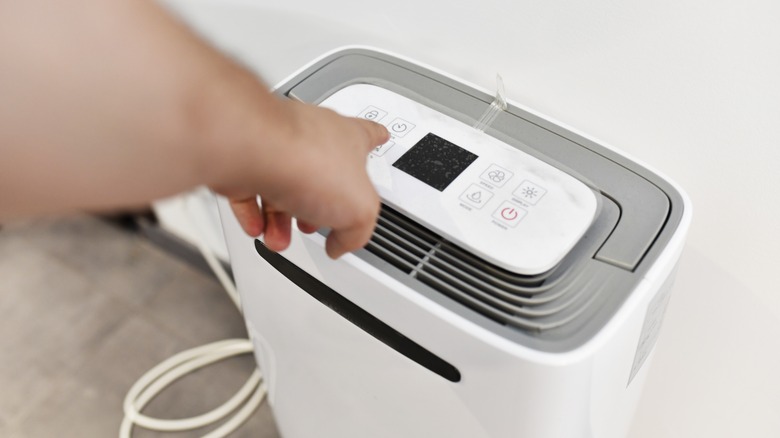The Best Ways To Keep Your Food From Growing Mold
We've all been there. You walk into your kitchen, craving a sandwich, only to find an unmistakable layer of greenish-gray fuzz spread across the bread. It's a discovery that ruins an afternoon and leaves you searching for something to blame. But sadly, mold is just a fact of life. Its spores are on our food, hands, and even in the air we breathe. When these spores find the right conditions — moisture, oxygen, and a food source — they take on a life of their own. Some molds, such as the kind on blue cheese and the white film on cured meats, are harmless, but others produce poisonous mycotoxins that can be hazardous to our health even when we cannot see them with the naked eye (via Carnivore Club).
According to the U.S.D.A., these toxic molds lurk under the surface of foods, meaning that even if you scrape off the visible mold, you haven't necessarily gotten rid of it. Although some foods are safe to eat when they're moldy, such as hard cheeses and hard fruits, others are not, and consuming them can have serious consequences.
The best way to avoid eating mold is to prevent it from growing on your food in the first place. Its spores may be almost everywhere, but you can take precautions to slow its growth so you don't have to abandon making that sandwich you were craving or fight with your partner about whether the bread should've been stored in the fridge all along.
Put perishable items in the refrigerator immediately
Mold grows best in warm, humid environments, and you can slow its development considerably by removing one or both of these conditions. You could purchase only dried fruits and starchy vegetables, but most of us would rather not give up fresh food altogether. This is where the refrigerator comes into play. As soon as you get home from the store, take just a few minutes to unpack and refrigerate perishable goods, and you'll extend the time you have to consume them by days or even weeks.
Lemons last only about a week at room temperature, but can last up to three weeks when chilled in a fridge below 40 degrees Fahrenheit. Cake will only last a day or two on your counter, but can stay moist and mold-free in the fridge for a week or more. Raw meat should never be left out of the refrigerator due to bacterial concerns, but it can last days in the fridge.
Even bread can benefit from refrigeration. You might shudder at the thought of putting it in the fridge, but unless it's a freshly baked baguette or an artisanal loaf from your local bakery, bread is not negatively affected by lower temperatures as long as you keep it in an airtight bag to avoid staleness. If you live alone or don't eat it at every meal, refrigeration is the best way to avoid throwing out half of every loaf you purchase.
Let baked goods cool completely before storing them
Most of us aren't thinking about mold growth the moment we pull a piping hot cake from the oven, but the way you handle your baked goods from this point will determine their susceptibility to mold in the future. Fungi love moisture, so your first goal should be to mitigate dampness as much as possible. The easiest way to do this is to let your baked goods cool completely before you store them.
As a freshly baked cake or loaf of bread cools, it releases steam that evaporates into the air. If you wrap the baked goods in plastic wrap before they're cooled, the evaporating moisture is trapped and turns to condensation, which creates the ideal conditions for mold. For this reason, you should also extract baked goods from their tins as soon as possible, and put them on a cooling rack so they do not develop the dreaded soggy bottom.
The only situation in which you might want to wrap your baked goods while they're still warm is if you have an overly dry cake and you want to trap in as much moisture as you can. But for most baked items, especially those with fruit or other moisture-rich ingredients, evaporating steam is an essential part of the cooling process, and skipping it could come back to haunt you.
Layer hard cheese with butter
We can probably all agree that butter is delicious, but it turns out it harbors even more magical powers. Have you ever noticed that the butter in your butter dish never seems to go bad? That's because its high-fat content makes it resistant to mold. In addition to moisture and oxygen, mold needs a food source to grow, and fat is not as inviting as protein and carbohydrates. While your bread and lunch meat develop the telltale fuzz, butter, which is a minimum of 80% fat (per U.S.D.A.), remains blissfully unblemished. Salted butter is even less susceptible to mold because many types of fungi are averse to salt.
Fat also serves as a seal because it has low water content and is not porous enough to let in oxygen. These factors have been harnessed by cheesemakers in the U.S., who have used lard and butter to protect hard cheeses from mold since the 18th century. Now known as bandaging, the preservation method involves soaking cheesecloth in melted fat, and wrapping it around the wheels of cheese to seal it from mold-friendly oxygen and moisture. Even if you aren't a professional cheesemaker, it could be worth trying it at home, and who doesn't want the faintest hint of butter in their Gruyère?
Wash produce with vinegar
Mold spores can be transferred to food via air and water, and the produce that you purchase from the store is likely carrying some already. Washing the spores off your fruits and vegetables as soon as you purchase them is a good first line of defense against mold growth. Instead of reaching for the dishwashing soap, pick vinegar instead. According to House Digest, this common pantry item has been shown to kill about 82% of mold species due to its high acid content, making it an excellent and natural way to rid your fruits and vegetables of invisible spores before they turn into mold. Vinegar has also been shown to kill about 98% of bacteria, even more than antibacterial soap (via NPR), so you don't even need to worry about doing a second wash to remove the germs.
To clean your produce with vinegar, create a solution made of three parts cold water and one part vinegar (since warm water could wilt greens and break down delicate fruits). Let your produce sit in the vinegar bath for about three minutes. Then run it under cold water and dry it with a paper towel to remove as much moisture as possible. You might worry that this method makes your food taste like vinegar, but as long as you rinse it thoroughly afterward, you'd never know it was washed in anything other than water.
Avoid touching food with your hands
There is no getting around it: our hands are filthy. If you don't believe us, try this at-home experiment created by C.S. Mott Children's Hospital in Michigan. It involves taking three slices of bread — one for the control, one for dirty, and one for clean — and putting them in separate plastic bags. When transferring the bread to the bags, use a pair of tongs for the control piece, unwashed hands for the dirty piece, and washed hands for the clean piece. Seal the bags and see what happens.
When a pair of teachers conducted the study with their class in 2019, adding a fourth slice of bread that was rubbed on everyone's laptops, and a fifth slice that was touched after the students used hand sanitizer, the results were so shocking that they went viral (per My Modern Met). After a few days, the pieces of bread that had touched the laptops and dirty hands were predictably covered in mold, but even the piece that had only been touched with washed hands showed patches of bluish fuzz. The piece that had only been handled with tongs, meanwhile, was pristine.
This experiment clearly illustrates how dirty our hands are even when they've just been washed, and how these germs speed mold growth. If you want to keep your food mold-free for as long as possible, use utensils to handle food, not your hands. Better yet, wash your hands first and then use the utensils.
Clean your refrigerator regularly
Mold does not grow nearly as easily in cold temperatures as in warm ones, but some types can still grow on refrigerated food. In fact, there might be some clinging to the refrigerator itself. Mold spores can transfer from food to the shelves and walls of your fridge, where they adapt and grow over time. This mold can then transfer to the new food you put there, creating a vicious cycle. The U.S.D.A. suggests cleaning your refrigerator every few months to prevent the spread of mold. Sometimes, you'll be able to see black specks, but spores are invisible to the naked eye, and can therefore be lurking on surfaces even if you can't see them.
To clean your refrigerator, use a clean cloth or sponge (bacteria and mold spores like to hang out on unwashed cleaning supplies), and a quart of water with one tablespoon of baking soda. Bleach and other chemical cleaners should not be used for any surfaces that will be touching food, including your refrigerator. Scrub the appliance from top to bottom, making sure to not miss any corners or crevices where mold might be hiding. Doing this every few months will be a powerful deterrent to any stray mold spores that are on your food or ones trying to spread.
Rearrange your refrigerator
In addition to cleaning it regularly, keeping your refrigerator organized is one of the best ways to keep your food mold-free. If you are not the kind of person who alphabetizes their spice jars or color codes their pantry, this may be a tough sell, but in this case, it's about functionality, not aesthetics. It won't just prevent mold, but it will save you money because you won't be throwing out as much food.
First, start thinking of your fridge as a conveyor belt, where the oldest items are at the front of the line and the newest are at the back. This prevents the all-too-familiar experience of reaching into the back of your fridge, and finding bags of unrecognizable slime and mold so old you can't even guess what they might have been. Labeling everything with masking tape will help you stay on top of what you're putting in the fridge, and what part of the imaginary conveyor belt it should be on.
Before going to the store, try to a make meal out of what you have left, even if it isn't part of your usual cooking repertoire. This will prevent food waste, and minimize the amount of food you have in the fridge. Overloading your fridge not only makes it less likely that you'll eat everything before it goes bad, but it can also block circulation, leaving parts of your fridge warm enough to invite mold, while other parts could be frozen.
Freeze food you aren't going to eat right away
Refrigeration is the best way to store food that you plan to eat within a week, but if you know you aren't going to finish something in that time, it's best to put it straight into the freezer. Maybe you only eat about half a loaf of bread a week, or made several servings too many of chicken soup. If stored correctly, both these foods will last months in the freezer without losing their flavor. According to the U.S.D.A., food stored at a temperature that is constantly below zero degrees Fahrenheit will be safe to eat because the freezing environment sends microbes into a dormant phase, preventing the growth of mold.
Certain foods do not handle freezing well. Fruits and vegetables that have high water content, such as tomatoes, lettuce, and grapes, are problematic because when the water turns to ice, it expands and ruptures their cell walls, leaving them mushy and unappetizing when thawed. In general, however, most foods retain their flavor and texture when frozen quickly in airtight containers. Meat, which has a notoriously short shelf-life in the refrigerator, can last months in the freezer, while starchy vegetables, such as potatoes, carrots, and broccoli, are also prime candidates for freezing. For best results, freeze food at peak freshness to preserve its flavor and nutritional value.
Use clean utensils for condiments
Unlike fresh meat and produce, condiments can sit in the fridge for months without being finished. Jars of jelly, mayonnaise, and ketchup take such a long time to eat that it usually comes as a surprise when you finally hit the bottom. Luckily, salt and sugar repel most molds due to their dehydrating properties, as does the low temperature of your refrigerator. But not even the most sugary jelly and saltiest jar of pickles can withstand all forms of mold, especially when spores are introduced via contaminated utensils.
Using as few utensils as possible when preparing a meal is a great way to limit the number of items you have to wash, but it also expedites the growth of mold. If you dip a knife into a jar of peanut butter, spread it across a piece of bread, and then dip it into a jar of jelly, you are almost certainly introducing mold spores to the jelly via microscopic bits of peanut butter and bread. Over time, these spores will take root and begin to multiply until you unscrew the lid one day and discover tufts of unwelcome fuzz. Using separate utensils is the best way to ward off mold on these long-term fridge dwellers and avoid wasting half-full jars of them.
Be intentional with food storage
The way you store food affects how susceptible it is to mold. If you store berries in a puddle of water in the fridge, they will become moldy much faster than if you dry them first and put a layer of paper towels under them. Keep different categories of food separate. Cured meats should not be near fresh produce, as the moisture from the produce can accelerate mold growth. Keeping bread in the freezer will stop mold in its tracks, but if you plan to eat it within a week, opt for the light air circulation and relatively dry conditions of a bread box. You should also use a breathable paper bag rather than a plastic one, as plastic can seal in moisture.
Even produce should be separated. Some fruits, including bananas, produce a hormone called ethylene as they ripen. When ethylene comes into contact with ethylene-sensitive produce, such as carrots, greens, and broccoli, it can cause them to spoil. This is why it's common to keep fruits and veggies in separate compartments of your refrigerator. To further complicate matters, however, fruit that does not continue to ripen once it's been harvested starts to break down when exposed to high levels of ethylene, creating ideal conditions for mold. Known as non-climacteric, these fruits include berries, grapes, and watermelon, and should be kept in a separate part of the refrigerator away from ethylene-producing fruit.
Lower the humidity in your house
You can dry your produce with paper towels all you want, but if your house is humid, mold will proliferate. The U.S.D.A. cites 40% or below as the ideal level of humidity for your home if you want to prevent mold growth. Mayo Clinic suggests anywhere between 30-50% humidity for health reasons, pointing out that overly dry air can cause dry skin, itchy eyes, and nose and throat irritation.
If you live in a dry area, such as Phoenix or Las Vegas, you probably don't need to worry about ambient moisture in your home causing your food to grow moldy. If you live somewhere humid, however, you may be fighting an uphill battle. This is particularly the case in places like Miami and Houston where the humidity is combined with heat. A well-ventilated kitchen will lower the humidity level, but if you live in a moisture-saturated part of the world where the outside air is just as humid as the inside air, investing in a dehumidifier will help you ward off mold in your home and on your food.
Look at expiration dates before you check out
Expiration dates are not particularly helpful when it comes to dictating whether food is safe to eat. According to the U.S.D.A., there is no federal regulation that requires them to be on food packages, and with the exception of baby formula, they are more of an indication of peak freshness than safety. The department suggests people look for signs of spoilage instead to determine whether or not a food is fit to eat.
While use-by dates are not very reliable when it comes to safety concerns, they can be helpful in regard to choosing which food is freshest when you're at the grocery store. If you buy a loaf of bread that is already past its prime, and you're planning to eat it over the course of a week, it will be much more likely to grow mold before you finish it than if you buy a loaf with a use-by date that's still a week away. Look at the expiration before you purchase food, and you won't end up with a nasty surprise a few days later.
